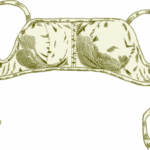A death during Victorian times required long periods of mourning traditions, and was accompanied by many grief rituals. The longest mourning period was for the death of a spouse, and usually lasted a minimum of 2 years. But just grieving wasn’t enough; a person was required to dress for the occasion. There were even stages of mourning, requiring different apparel. Full Mourning lasted a year and one day, and women were expected to wear black crepe or dull materials that had no sheen or shine. Crepe was a very hazardous material, and constant breathing through the fabric caused many respiratory problems. Black was the preferred color because it symbolized the absence of light and life. (Even the petticoats had to have a black ribbon sewn on the hem, in case they should be seen.) Special mourning lace handkerchiefs had black borders. For the head, there were special bonnets, caps and veils for grieving women. These veils, most often made of heavy black crepe, sometimes caused blindness, because they were in close contact with the eyes, for long periods of time. During crying fits, the large cuffs on the dresses would be used to wipe the nose, and they were referred to as “weepers.”
For one entire year, a woman could not leave her house without Full Mourning attire and a weeping veil. She could attend church services, but was never to be seen at places of amusement or entertainment. Even the houses were fully draped in black crepe banners to signify that there had been a death.
Some elderly widows remained in mourning for the rest of their lives. Queen Victoria had made mourning a fashionable tradition. Her husband, Prince Albert, died of typhoid in 1861. She dressed her entire court in mourning attire, and remained in Full Mourning clothes for 3 years.
Many children never saw their mothers in any color except black, for their entire life, because of so many deaths in the family.
Second Mourning was the next phase, and it lasted for nine months. Dresses were still made from drab material, but some fabric trim was allowed, as well as mourning jewelry. The veil could be lifted, and worn back over the head.
Half Mourning was the next phase, and it lasted from 3 to 6 months. Nicer fabrics could be used, and there was a gradual trend toward wearing colors again. Any type of jewelry could be worn during this grief period.
Desired by all, mourning attire was a way to show wealth and respectability. But many poor people could not afford the appropriate clothing, and resorted to throwing everything they owned into a large vat of black dye, which they stirred with a pole until the color was absorbed. After their required mourning period was over, they would struggle to bleach out the black color.
Men had it much easier during times of grief. They had a shorter mourning time and simpler clothes. Some men wore full black suits, but most men just wore a black hat band, and a black armband. They could go about their daily activities and return to their workplaces.
Though mourning jewelry has existed for thousands of years, it reached its peak during the Victorian era. Only jet (black amber) jewelry was allowed during First Mourning. Hair art was a popular trend. Hair of the deceased would be incorporated into lockets, brooches, watch fobs, and rings.
With the death of Queen Victoria in 1901, grieving rituals changed dramatically, as the Victorian etiquette began to disappear. But in America, particularly in the South, things had been changing rapidly long before her death. The Civil War was in full force, and so many southern soldiers had died, that almost the entire South was in mourning. (Many Northern soldiers died as well.) The morale of the Southern people was greatly affected by the sight of so many women dressed in Full Mourning clothing. It was so depressing, that the Governor of Mississippi actually tried to pass a law banning the Victorian mourning garments.
America’s mourning traditions were changed out of necessity, as we engaged in various wars. With so many men on the battlefield, women were forced into the workplace, and could no longer abide by the restrictions that the elaborate grief process required.
One benefit of these grief rituals, was that they allowed the grieving person to acknowledge their loss publicly. Much more time was allowed to grieve a close loved one in those days, as death was not a taboo subject. However, the rituals were so confining and oppressive. If a woman had been abused or mistreated, she would still be required to mourn her abuser for a long period of time. Walking around for years in widow’s garb, with no form of entertainment, would be enough to push many women over the edge emotionally. Our society today, can take some valuable lessons from Victorian grieving practices, but I am very thankful that we no longer have to observe such restrictive rituals.
Sources: http://www.victoriana.com/VictorianPeriod/mourning.htm
http://www.morbidoutlook.com/fashion/historical/2001_03_victorianmourn.html




